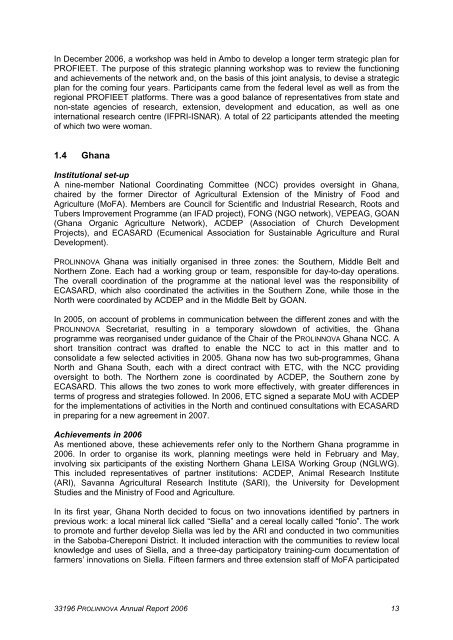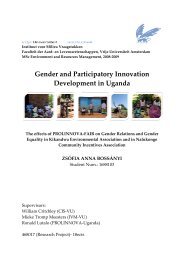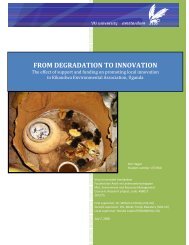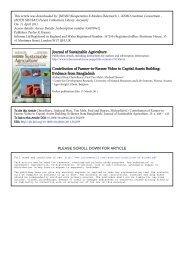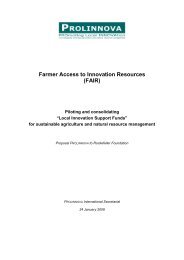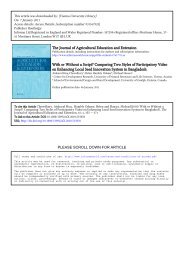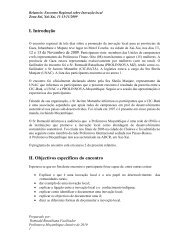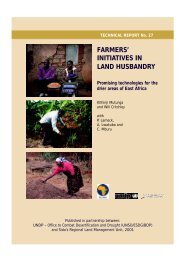2006 ANNUAL REPORT & PROGRAMME REPORT ... - Prolinnova
2006 ANNUAL REPORT & PROGRAMME REPORT ... - Prolinnova
2006 ANNUAL REPORT & PROGRAMME REPORT ... - Prolinnova
Create successful ePaper yourself
Turn your PDF publications into a flip-book with our unique Google optimized e-Paper software.
In December <strong>2006</strong>, a workshop was held in Ambo to develop a longer term strategic plan for<br />
PROFIEET. The purpose of this strategic planning workshop was to review the functioning<br />
and achievements of the network and, on the basis of this joint analysis, to devise a strategic<br />
plan for the coming four years. Participants came from the federal level as well as from the<br />
regional PROFIEET platforms. There was a good balance of representatives from state and<br />
non-state agencies of research, extension, development and education, as well as one<br />
international research centre (IFPRI-ISNAR). A total of 22 participants attended the meeting<br />
of which two were woman.<br />
1.4 Ghana<br />
Institutional set-up<br />
A nine-member National Coordinating Committee (NCC) provides oversight in Ghana,<br />
chaired by the former Director of Agricultural Extension of the Ministry of Food and<br />
Agriculture (MoFA). Members are Council for Scientific and Industrial Research, Roots and<br />
Tubers Improvement Programme (an IFAD project), FONG (NGO network), VEPEAG, GOAN<br />
(Ghana Organic Agriculture Network), ACDEP (Association of Church Development<br />
Projects), and ECASARD (Ecumenical Association for Sustainable Agriculture and Rural<br />
Development).<br />
PROLINNOVA Ghana was initially organised in three zones: the Southern, Middle Belt and<br />
Northern Zone. Each had a working group or team, responsible for day-to-day operations.<br />
The overall coordination of the programme at the national level was the responsibility of<br />
ECASARD, which also coordinated the activities in the Southern Zone, while those in the<br />
North were coordinated by ACDEP and in the Middle Belt by GOAN.<br />
In 2005, on account of problems in communication between the different zones and with the<br />
PROLINNOVA Secretariat, resulting in a temporary slowdown of activities, the Ghana<br />
programme was reorganised under guidance of the Chair of the PROLINNOVA Ghana NCC. A<br />
short transition contract was drafted to enable the NCC to act in this matter and to<br />
consolidate a few selected activities in 2005. Ghana now has two sub-programmes, Ghana<br />
North and Ghana South, each with a direct contract with ETC, with the NCC providing<br />
oversight to both. The Northern zone is coordinated by ACDEP, the Southern zone by<br />
ECASARD. This allows the two zones to work more effectively, with greater differences in<br />
terms of progress and strategies followed. In <strong>2006</strong>, ETC signed a separate MoU with ACDEP<br />
for the implementations of activities in the North and continued consultations with ECASARD<br />
in preparing for a new agreement in 2007.<br />
Achievements in <strong>2006</strong><br />
As mentioned above, these achievements refer only to the Northern Ghana programme in<br />
<strong>2006</strong>. In order to organise its work, planning meetings were held in February and May,<br />
involving six participants of the existing Northern Ghana LEISA Working Group (NGLWG).<br />
This included representatives of partner institutions: ACDEP, Animal Research Institute<br />
(ARI), Savanna Agricultural Research Institute (SARI), the University for Development<br />
Studies and the Ministry of Food and Agriculture.<br />
In its first year, Ghana North decided to focus on two innovations identified by partners in<br />
previous work: a local mineral lick called “Siella” and a cereal locally called “fonio”. The work<br />
to promote and further develop Siella was led by the ARI and conducted in two communities<br />
in the Saboba-Chereponi District. It included interaction with the communities to review local<br />
knowledge and uses of Siella, and a three-day participatory training-cum documentation of<br />
farmers’ innovations on Siella. Fifteen farmers and three extension staff of MoFA participated<br />
33196 PROLINNOVA Annual Report <strong>2006</strong> 13


